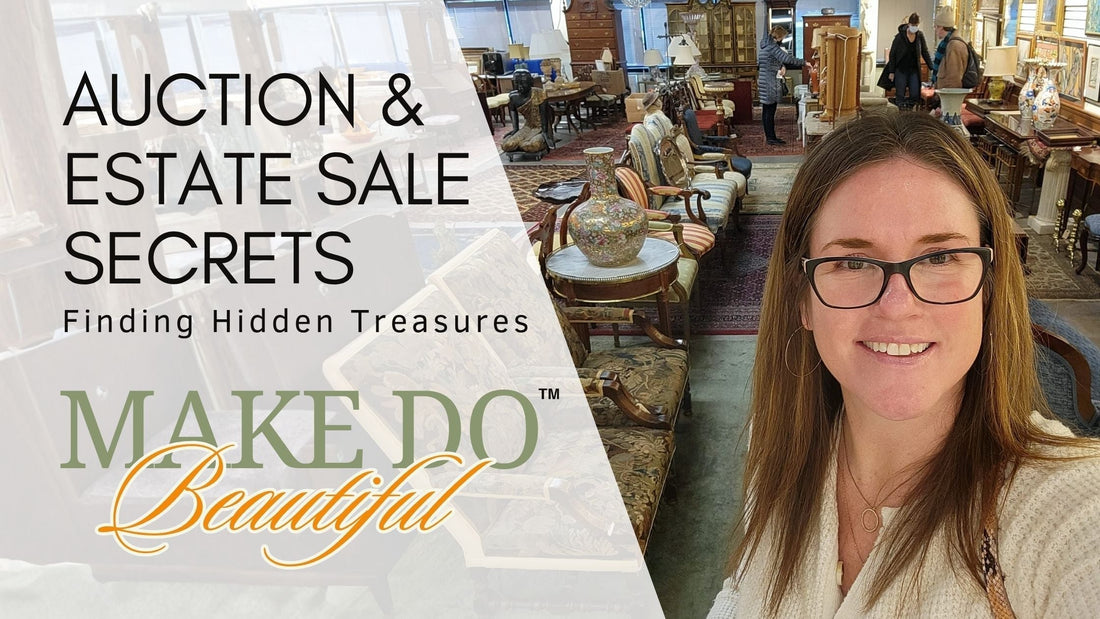
Auction & Estate Sale Secrets: Finding Vintage Furniture and Hidden Gems
Treasure hunting once-loved pieces is one of my favorite ways to add charm and character to any home. It’s a beautiful way to practice conscious consumption and bring more story-driven design into our spaces. I want to share a few antique shopping tips I’ve picked up—from finding the best sales and auctions to trusting your intuition, and uncovering hidden gems like rare artwork or vintage furniture. With a little preparation, your auction treasure hunting can be more enjoyable, efficient, and wonderfully rewarding.

Viewing day at an auction house in Rockville, MD
How to Find Estate Sales (And Other Goods)
Sure, a quick Google search will reveal plenty of opportunities, but I recommend taking your search further to find the best spots for thrifting home decor. Start by asking friends for recommendations or using websites like EstateSales.org to locate auctions and estate sales by zip code. After attending a few events, you'll naturally gravitate toward those that fit your unique style and budget.
Viewing In-Person is Key to Buying Secondhand Decor
With so many auctions moving online, it’s important to view items in person when possible. Many auction houses offer prescheduled view dates or private appointments. My process for staying focused is to preview items online first, mark my "favorites," and bring a printed list organized by lot number. This helps me avoid overspending.
Don’t be shy when viewing—this is your chance to thoroughly inspect and discover flaws that may influence your strategy.
- Sit in chairs to check for sturdiness.
- Look under seats for hidden damage.
- Carefully move pieces away from the wall to inspect the backside.
- Open all drawers and cabinets to ensure they work smoothly.
- Closely examine paintings for any cracking or scratches.
More Inspection Secrets for Hidden Gems at Auctions:
- Take a whiff! Strong odors could signal hidden issues like pet damage, smoke, or mold, which might require extra time and money to fix.
- Your phone is a must. With photo recognition technology, you can simply take a picture of an item, and an app will provide relevant details, such as the item’s name, origin, age, and estimated value.
Trusting Your Gut for Timeless Vintage Home Styling
If something makes you stop and say, “I love this,” trust that instinct! Two of my most memorable finds came from simply listening to my gut. One was a panetière—a hand-carved dark wood piece I initially thought was religious in nature. After weeks of research, I learned it was a bread safe that was given as a wedding gift during the 19th-century in Provence, France! Another great find was a Victorian gossip chair. The missing armrest, designed for overflowing bustled dresses, baffled me, but I knew it had to be something special. Both pieces spoke to me because of their unique craftsmanship, and they turned out to be wonderful investments.

Victorian Gossip Chair
Also, remember the art of letting go. Be emotionally prepared for those moments when you don't win the bid to avoid getting swept into overspending.
We are all on a journey of discovering and repurposing old furniture and soulful objects to create cozy homes. Try it your way, and you might be surprised what’s right in front of you. Together, let’s enjoy the process.

19th-Century Panetière
I hope these estate sale secrets help you on your next treasure hunt! Let's connect in the comments. Have you found any amazing vintage furniture or hidden gems recently? Share your stories and antique shopping tips below!
Frequently Asked Questions
How do I find local estate sales and auctions?
You can start with a Google search, ask friends for recommendations, or use specialized websites like EstateSales.org to search by zip code.
What are the best tips for buying at estate sales?
Preview items online first, bring a list of "favorites" by lot number to stay focused, inspect items thoroughly in person (checking for damage/smells), and be prepared to walk away to avoid overspending.
How can I tell if vintage furniture is a good investment?
Look for unique craftsmanship, sturdy construction, and pieces that resonate deeply with your style and intuition. Using a photo recognition app can also provide an estimated value.
What are some red flags to look for when inspecting antiques?
Check for weak joints, hidden damage (by looking underneath and behind pieces), drawers/cabinets that don't operate smoothly, cracks/scratches on art, and strong odors like smoke or mold.
Is it better to buy from an auction or an estate sale?
It depends! Estate sales typically have fixed prices, while auctions are bid-based. View in-person first whenever possible, as both can offer great finds.
How can I avoid overpaying at an auction?
Preview items and set a maximum price for your "favorites" before the auction starts. Be emotionally prepared to let the piece go if the bidding exceeds your budget.
What is a "panetière" and what is a "gossip chair"?
A panetière is a 19th-century French bread safe, often hand-carved. A Victorian gossip chair is a unique, often small chair that sometimes featured a missing armrest designed to accommodate overflowing bustled dresses.
What is the best way to clean and restore vintage finds?
While not detailed here, a crucial first step is to assess for hidden issues like mold or pet damage (by checking for strong odors) before bringing it home, as this will influence your restoration plan.
How can I incorporate secondhand decor into a modern home?
Focus on pieces that bring a soulful, collected, and timeless character to your space. Trust your intuition and let the beautiful imperfections tell a story.
What's the secret to finding rare art at an estate sale?
Thorough in-person inspection is key—look closely for any cracking or scratches on paintings. Use your phone's photo recognition to quickly check for origin and value.

